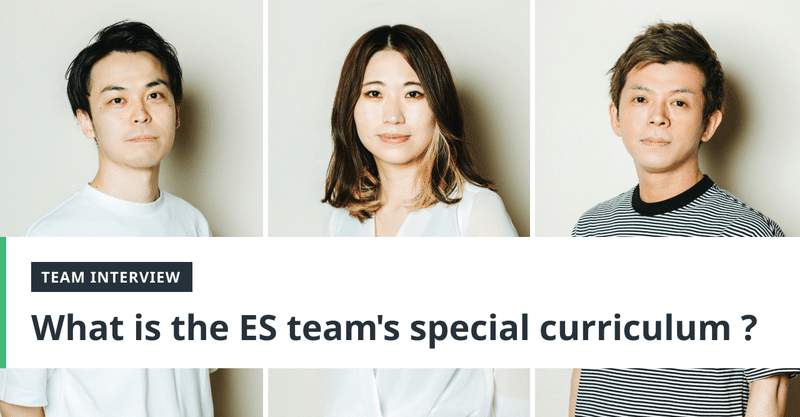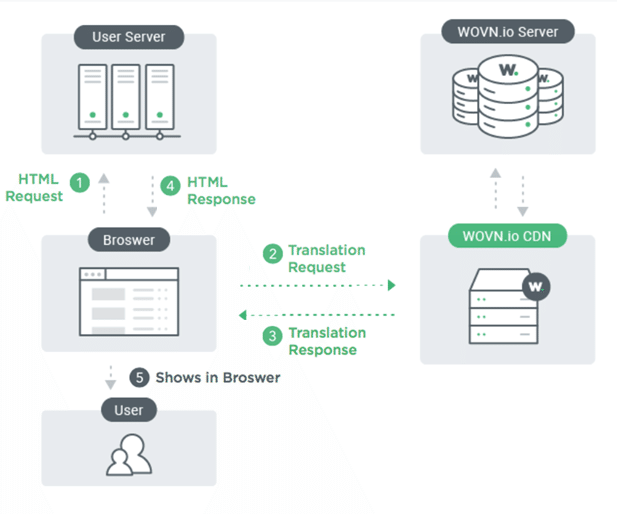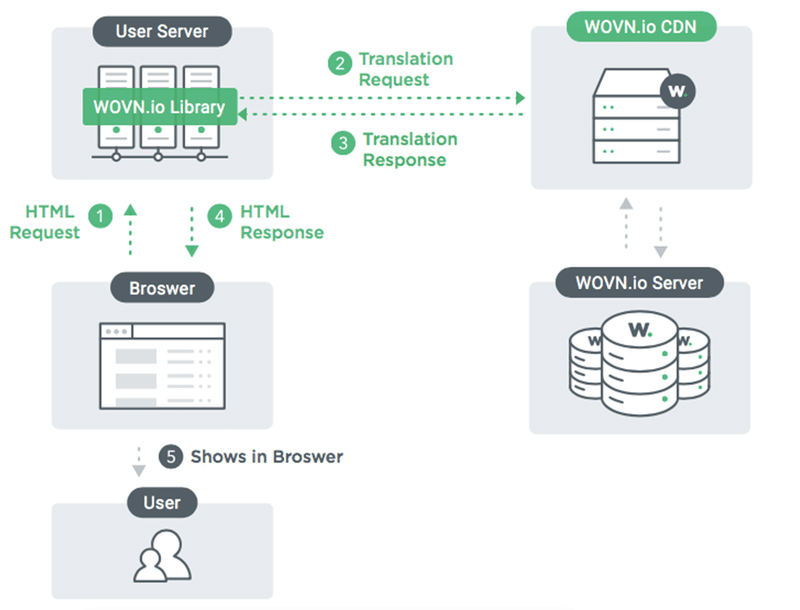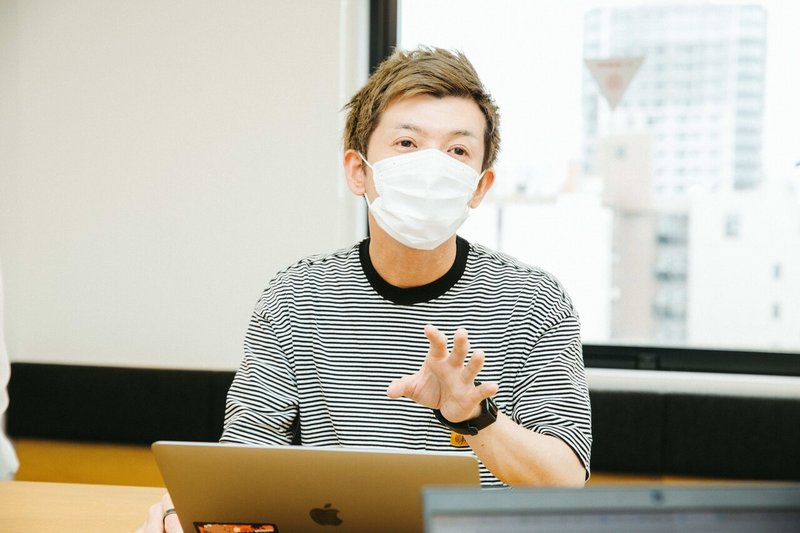
A system for training even young employees to work independently. We took a comprehensive look into the ES Team’s OJT program.
Hello! I'm Yuka from HR.
In this article, we’ll be covering a question that HR members at WOVN are often asked through the opinions of employees we interviewed.
On this occasion, we interviewed members of the Enterprise Success (ES) team to answer the question of “it looks like WOVN’s ES team is open to young people, but can young people that don’t have web or IT-related knowledge/experience thrive too?”
We spoke with Mr. Matsumoto and Ms. Tamura, who are in charge of training for new members, and Mr. Kitano, who joined WOVN six months ago.
We found that efforts to enable young employees include a structured training program motivated by bitter experiences and a support system which gives new members a comfortable environment.
* If you want to learn more about what Enterprise Success is, click here to read the articles about ES team leaders Mr. Yamazaki and Mr. Kudo.
OJT programs (does no experience cause difficulties?)
- What kind of education and training does the ES team provide to new members?
Matsumoto: We use the ES team’s own OJT program to educate new members.
The program consists of a three-step curriculum, and this allows new members to reach independence within six months.
The first step involves learning basic information about WOVN. In addition to the company's vision, mission, and organizational structure, we take a week to teach new members the WOVN integration methods and the needed mindset.
The second step is learning about one of the WOVN integration methods, the script method (*1), and trying it out in an actual project. After that comes the library method (*2), and we also have new members learn and try it out in an actual project.
*1 Script Method
An easy way to enable translation by adding a one line of script to the html code for a page.

*2 Library Method
Integration via this method takes some time, but this covers the disadvantages of the script method.

Tamura: During OJT, new members form pairs. They are in charge of three to five projects that focus on specific tasks while they get a feel for the overall processes. However, we of course give new members ownership of a project if we feel that they can do so.
Once new members can handle library integration by themselves, we put them in a post-OJT interview, and that’s the end of the training program. Through this, new members are able to become independent in around three to six months.
- OJT programs often give people the impression that they involve watching your senior complete tasks then learning as you handle tasks yourself, but WOVN’s OJT program allows time for learning and digesting information.
Despite this, I think what still worries people is whether they will be okay joining with no experience – will it be tough if you don’t already have a lot of skills?
Matsumoto: Members of the ES team have to lead integration projects for clients, so it’s best to have both knowledge and experience in IT and project management.
However, as our program has its participants learn before they put that knowledge into practice, those who have experience in either one of the two will be able to self-study after they join to catch up on what they don’t know.
Regardless of the experience that you have, WOVN’s new members are all beginners when it comes to WOVN, so there’s no doubt that proactive workers will thrive the most.
Mr. Kitano joined the company without much IT or web-related knowledge, but I thought he grew very quickly thanks to his self-study.

(Mr. Matsumoto passionately talking about WOVN’s OJT program which he designed and runs)
Kitano: It's embarrassing to hear that about myself! (laughing)
I learned about HTML through a website for self-study and would borrow a server to make websites. I would also integrate WOVN into those websites. The constant cycle of learning and putting what I learned into practice really helped me commit everything to memory.
Reasons for leaving a "cool" planning job for WOVN
- I want to hear from Mr. Kitano next. Can you tell us what you did in your previous job?
Kitano: I previously worked at a mega venture, where I did business planning.
My job involved managing the drafting, planning, and launch of new services within the Product Management Office (PMO). It was often difficult to coordinate the 50+ people in the company, but I was able to have an interesting experience despite being a new-graduate member.
- I feel that planning work at companies is a very popular field of work. Why did you decide to switch jobs?
Kitano: There are three reasons why I decided to switch jobs.
Firstly, I was interested in working with clients. In my previous job, I was mainly in charge of planning upstream processes, so I didn't have the opportunity to actually interact with customers, so when thinking about my future career, I felt that I wanted to have the experience of working on the frontlines while I was still young.
Secondly, I wanted to develop my knowledge and skills. I enjoyed my previous job, and I thought it looked like a cool job from an outside perspective too, but when people would ask me what my job had taught me, I couldn’t give a confident answer. This led me to want to develop more concrete skills.
Thirdly, and finally, I wanted to have a large impact on something. In my previous job, for better or worse, the organization was already mature, so I wanted to have a job which allowed me to act independently to create a larger impact and see the bigger picture.

(Mr. Kitano had no trouble explaining his reasons for changing jobs although it had been over half a year since he was last asked)
In searching for jobs with those reasons in mind, I stumbled across WOVN.
The scale of the company and its business was smaller than that of my previous company. I was honestly worried about jumping into an environment with many members coming with experience in software engineering and IT consulting.
However, I was strongly attracted to the originality and potential of the product and the uniqueness of the position, which would allow me to experience both downstream and upstream processes, so I decided to join.
Creating a comfortable WFH environment through OJT and one-on-one meetings
- Sorry to put you on the spot in front of OJT supervisors, but how do you feel about WOVN’s OJT program after experiencing it yourself?
Kitano: I was glad to have the opportunity to learn first, as opposed to being assigned to projects straight away. This helped me self-study and enabled me to reach a point where I could work independently faster.
Additionally, there a thing called a “skill map” which allows you to see your progress, so I thought that was good as well. I was able to focus on catching up in areas on the sheet where there was little progress, and I successfully covered the areas I didn’t have an understanding in.
And of course, the support of OJT supervisor Ms. Tamura was also great. For one month after joining the company, I was given the opportunity to have one-on-one meetings every morning for 30 minutes, and as we were able to stay on the same page with regards to my daily tasks and troubles, I constantly had a clear picture of what to do.
I was very relieved to have an environment where I could easily ask questions and receive thorough help, even while working remotely.
Tamura: It’s great to hear that and it makes me really happy!

(Tamura looking overjoyed as she receives positive feedback from Mr. Kitano)
There's a lot the three members want to do! Their vision for future OJT programs
Let me ask you about future OJT programs.
There are plans for recruiting more ES members, but what kinds of plans do you have for future OJT programs?
Kitano: I expect that a wide range of people will be joining in the future, so it would be good if we can have members kick off well relative to their skills and experience.
For people without a background in IT, we would define what we want them to work on before they join. This would help them cut down on the problems they would need to tackle.
At the same time, I want to create a system that ensures that every new member experience an equal number of projects.
At the moment, there's a significant gap with projects assigned to new members, with some being 2 months long and others up to 6 months. This leads to inconsistency with when members become independent. I want to enable new members earlier on by ironing out these inconsistencies.
Matsumoto: I agree with Mr. Kitano's opinion.
Currently, there are a lot of things that we have employees learn by themselves, but each employee faces their own challenges and has different areas to improve, and this is leading to this variance.
The aim of the OJT program is to standardize the growth of each individual, regardless of their skills and experience, so I would like to continue providing everyone with a good environment and good mentors to make this happen.
Apart from OJT, I want to further develop our company-wide onboarding programs too. As we’re all working together, I want to increase the number of opportunities our employees have to learn more about and catch up on our products.
Tamura: This is a bit off-topic, but as someone working on OJT, one of the problems that I want to overcome is the problem of workshop materials quickly becoming outdated. WOVN's technical capabilities are really amazing, with more than 250 features developed and added a year, so the services are being updated at a very fast pace. Refining the management of this is something that we need to attend do.
Also, the OJT program is a one-on-one program, so I would like to provide more opportunities for communication within teams. It’s difficult when an OJT supervisor is busy and you don’t know who to reach out to, right?
At the moment it’s hard to communicate with people, but it would be great if we could facilitate better communication so that teams can work better together.
We are looking for new teammates at WOVN! Apply here!
Click here if you would like to learn more first!
この記事が気に入ったらサポートをしてみませんか?
